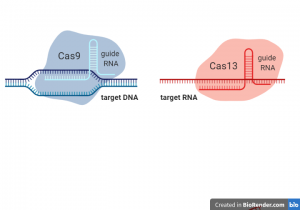Femke van Hout
The last decade marks the exciting revolution of CRISPR/Cas9 genome editing. While the revolution still continues with further development and refinement of the Cas9 systems, the first patients are already receiving Cas9-based treatments. The Cas9 enzyme is a so-called “RNA-guided DNA nuclease”. This means that Cas9 is directed by RNA, the guide RNA, to find and cut the complementary target DNA. As this cutting mechanism is very precise and programmable, Cas9 can in theory be used to change any DNA sequence. Many diseases could potentially be cured, including sickle cell disease, Duchenne muscular dystrophy and Huntington’s disease [1]. However, changing someone’s DNA could have severe implications regarding safety and ethics.
Luckily, it turns out that Cas9 has many siblings. Among them, is the recently discovered Cas13 that cuts RNA instead of DNA, making Cas13 an “RNA-guided RNA nuclease”[2]. This means that Cas13 can be used to cut RNA encoding for disease-causing proteins. In this way, the production of the disease-causing protein is prevented, without modifying the genome!
The first successes with Cas13 in human cell lines and mice have been published recently. In one important example, the mRNA encoding for the KRAS protein was targeted, which is often found to carry mutations in pancreatic cancer [3]. However, no drugs exist to target the KRAS protein. Cutting the KRAS mRNA would therefore be an effective strategy to prevent the production of the mutant protein. With guide RNAs that recognise the KRAS mRNA, Cas13 reduced the mRNA level with 94%. This resulted in the apoptosis of cancer cells in vitro and tumour shrinkage in the mice model.
The fact that Cas13 can prevent the production of disease-causing proteins, without changing the DNA is a very important advantage of Cas13 over Cas9. Moreover, Cas13 can be used to cure diseases for which there is no DNA to target. The vast majority of the viruses that cause human disease have an RNA genome. Apart from the retroviruses, these RNA viruses do not have any DNA intermediate in their replication cycle. Therefore, Cas9 cannot be used to target these viruses, while Cas13 can. With guide RNAs targeting influenza virus A and SARS-CoV-2, Cas13 has already been shown to effectively degrade the viral RNA, mitigating the viral infection in human cell lines [4]. All in all, the Cas13 enzyme has great potential for the treatment of various human genetic diseases, cancers and virus infections.
References:
[1] Wu, S.-S., et al. Advances in CRISPR/Cas-based Gene Therapy in Human Genetic Diseases. Theranostics 10, 4374-4382 (2020).
[2] Abudayyeh, O.O., et al. RNA targeting with CRISPR–Cas13. Nature 550, 280-284 (2017).
[3] Zhao, X., et al. A CRISPR-Cas13a system for efficient and specific therapeutic targeting of mutant KRAS for pancreatic cancer treatment. Cancer letters 431, 171-181 (2018).
[4] Blanchard, E.L., et al. Treating Influenza and SARS-CoV-2 via mRNA-encoded Cas13a. bioRxiv, 2020.2004.2024.060418 (2020).

Figure 1: Schematic representation of the Cas9 en Cas13 enzymes with guide RNA and target DNA/RNA, created with Biorender.com.
